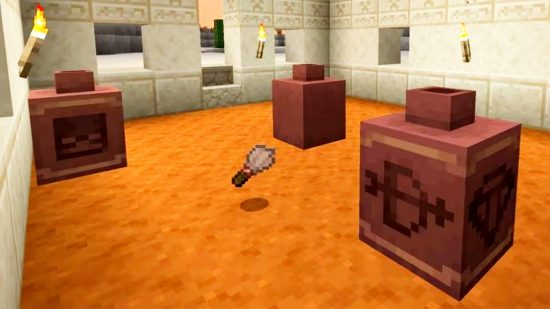The Minecraft archeology system was an exciting new mechanic first announced as part of the massive, but controversial, Caves and Cliffs update. A number of announcements made at the same time were eventually shelved, including bundles and archeology, while The Warden and its Deep Dark biome were delayed as part of the update being split in two. This was no bad thing, as it was due to so much more content being added than originally planned, and now, the archeology system is officially back in business.
Thanks to the delays, changes, and disappointments of previous updates, Minecraft 1.20 is evolving a little differently, with no features being revealed until they are definite, and no official name. Both the community and development are shaping the update organically ahead of its full rollout. The latest reveal confirms that archeology is now officially one of the features coming with the Minecraft 1.20 release date, as confirmed by Mojang Studios. To refresh your memory on the mechanic, here’s everything we know about the Minecraft archeology update.

Minecraft archeology
The archeology system brings some new items to the sandbox game, including a new sand block. If you think there are already too many sand blocks to contend with, bear in mind that archeology would be a whole lot more difficult if there weren’t something to signpost that you’re looking in the right place. To obtain mysterious ancient artefacts in your Minecraft world, you must dig up specific blocks, brushing the sand off them to reveal what is hidden beneath.
Suspicious sand
The block you’re looking for is called suspicious sand, and will initially only be found in Minecraft deserts, specifically inside rare desert temples. To help you find a dig site quicker, Minecraft seeds with large deserts near spawn are ideal, and we even have one on our list.
All we know so far is that you should be digging somewhere inside the desert temple, so be careful not to fall to your death in the structure’s explosive trap. We’ll give you more information on where and how deep to dig – as well as what suspicious sand actually looks like – once the feature arrives in an upcoming snapshot.
Archeology brush
We don’t yet know what the crafting recipe for the brush is, or where it might be found, but we do know that one is required for retrieving the secrets from within a suspicious sand block. In other words, suspicious sand is actually just something else covered in sand that needs brushing away.
Pottery shards and pots
Right now, that “something else” is a pottery shard. Each has its own unique image on it, and four of them can be combined into a decorative pot – perfect for your desert themed Minecraft builds.
In the original Minecraft archeology reveal, other valuable items such as diamond blocks could be uncovered with a brush, but for now it seems that the only thing available through this method of digging is pottery. Some fans, however, have suggested that archeology might be a great way to find smithing templates, part of the new Minecraft armor trims mechanic.
Perhaps this means that other seemingly scrapped content ideas might be back for Minecraft 1.20, too, so we’ll keep our ear to the ground regarding the likes of bundles, fireflies, and a birch forest revamp. There’s no doubt that, thanks to regular updates like these, Minecraft remains one of the best PC games right now. If massive changes to Minecraft gameplay keeps you coming back year after year, then there are plenty of Minecraft mods to keep you busy as well. If you just want to keep it vanilla, then familiarise yourself with upcoming features, such as Minecraft camels, ahead of the survival game’s next update.
Minecraft archeology system explained
Source: Maharot News


No comments:
Post a Comment